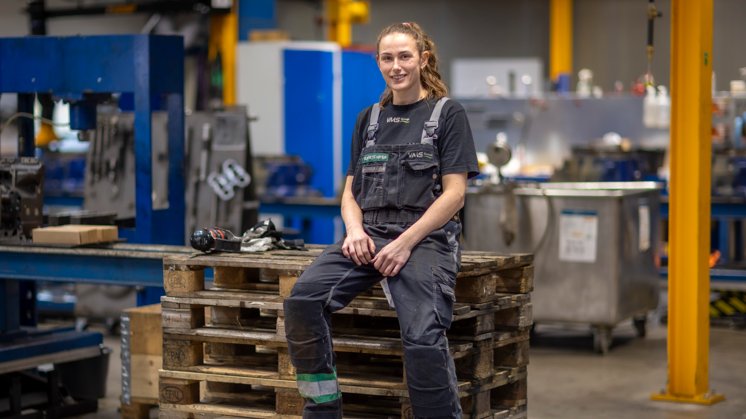Jeanette Høyer is a newly trained ship fitter, and immediately after her apprenticeship she started work at her apprenticeship, VMS Group in Frederikshavn.
In the company’s large maritime workshop, they work with parts for marine engines in size XXXL.

Jeanette Høyer has just passed her apprenticeship test and got a job at her apprenticeship. Photo: Martél Andersen
Here, Jeanette Høyer is the only female ship fitter – and of the women in other trades at the workshop, there is only one more woman, an aspirant machinist.
For many women, it will probably not be an obvious choice of education to become an apprentice as a ship fitter, and EUC Nord states that only one out of the 56 students who attend the latest intake of young students on their education are women.
You can probably safely call it a distinct male profession.
But becoming a ship fitter comes quite naturally to Jeanette Høyer, who has always been interested in working with engines.
– From my childhood, there has always been a lot of screwing up at home. I myself had many projects with mopeds together with my brother, and I myself have ridden a moped and fixed my own moped, says Jeanette Høyer.
She remembers what she did when her moped ran badly: took it apart and put it back together, and then when it ran better, it was a matter of finding out, why it now ran better so she could optimize it.

Jeanette Høyer is happy to work in the workshop, where she solves many different tasks. Photo: Martél Andersen
Now she works in a different league within engines:
– It’s fascinating with engines of that size. It’s a big ship, and it has to move some forces, she says.
It probably also played into the choice of education that Jeanette Høyer has several other fitters in the family – her father, brother and uncle.
As a child, she often pestered her father to be allowed to come along on small tasks when he had to leave.
A precision work
At VMS Group, they mainly work with engines, gears and propellers for ships.
This day, one of Jeanette Høyer’s tasks is to assemble some cylinder heads for ship engines. These are cylinder heads that have been out sailing, and now they need to be washed, sanded and some parts replaced.
– We check and measure that everything is as it should be. We calculate within very small margins, and we use a lot of micrometer screws, explains Jeanette Høyer.
She has many different tasks at the workshop. In her education, she has been in all departments in the company, where she has worked, for example, with pumps, welding, electricity and with turbochargers both on board ships and in the workshop.

Vocational education is still very gender-segregated. Photo: Martél Andersen
– I am employed as an octopus or joker, where I am a bit everywhere, but mainly it is engines, says Jeanette Høyer.
Things are said directly
Jeanette Høyer is fine with being a woman in a workshop full of men.
– That’s what I enjoy the most. There’s a very different sense of humor, but I’ve always gotten into it. There is a slightly freer tone and more fun, she says.
Few women train in the industry
Not many women attend EUC Nord’s maritime training programs for ship fitter and maritime blacksmith.
This is what Susanne Ørndal Bucholtz, education consultant in the school’s maritime area, tells us.
– It’s far too little. If we talk about those who come directly from primary school, we had 56 this year, and there was one girl in between, she says.
This is the year that started after the summer holidays this year.
On basic course 2, which is for those who are a little older and have tried something else, it looks better.
– There we have 14 on a team, and four of them are girls. But it’s atypical, we’ve never tried that before, says Susanne Ørndal Buchholtz, who doesn’t know if it’s a trend or just luck.
She has no clear answer as to why there are so few women on the two programmes.
– We have talked about this a lot, and the industry would really like to have more people in education, both men and women. And it is obvious to get more women into the industry, because they can add something different to men, says Susanne Ørndal Bucholtz.
The job opportunities with a diploma as a ship fitter or maritime blacksmith are excellent, says Susanne Ørndal Bucholtz, who points out that it is a growing industry.
– When I visit these companies, they say that they lack labour, especially journeymen. They are so hard to get hold of, they can only steal from each other. And the average age is so high that at some point there will really be a lot of labor, she predicts.
The 56 new students who have started the education at EUC Nord have all been given internships.
It’s not something that makes a difference to her.
– But there is no doubt that there is not the same kind of banter as there can be in a women’s workplace. Here things are said more directly, and if someone has a problem, it is said out loud instead of being talked about in corners. And I like that, says Jeanette Høyer.
Workshop humor also has its own characteristics:
– It’s black. Just like the profession, Jeanette Høyer smiles.
Women are strong enough
Kim Brohus is a foreman and apprentice manager at VMS Group, which has apprentices within warehouses, such as blacksmiths, industrial technicians and ship fitters, and he would like to see more female apprentices.
Right now, only three out of a total of 26 apprentices are women.
– It can be an advantage for the conversation in the workshop, it becomes a bit more broad instead of it just being men’s talk, he experiences.

Kim Brohus usually compares his industry to the ice cream shop in Tversted: – You can stand and have to close and have sent your colleagues home, and then there are two buses with after-school students. That’s how it is here too, says Kim Brohus. At VMS Group, it may instead be a customer who calls and says that they are lying in front of Frederikshavn and need help so that they can get on to Norway the next day. Photo: Martél Andersen
Kim Brohus also points out that there are good development opportunities in the profession.
And if anyone thinks that women are not strong enough for that job, the reality is different:
– Today there are so many aids. We can’t tell the difference if they are women. There is nothing they cannot do, says Kim Brohus.
Jeanette Høyer can recognize that picture:
– Last week I had to lift a five ton generator, no one can do that. But then we have aids, she says.

Kim Brohus is foreman and apprentice responsible for the 26 apprentices at VMS Group, who are divided into warehouse, blacksmith, industrial technician and ship fitter. Jeanette Høyer is one of the few women and has just finished training as a ship fitter. Photo: Martél Andersen
On the other hand, fitness is important, because a ship fitter needs to climb stairs – and many of them.
– It can sometimes be 17 floors on a cruise ship, says Kim Brohus.
Also on a drilling rig, you may need to be fit to take a lot of stairs.
– You can climb 100 floors there in one day. You can feel in your legs the next day that they are tired. Of course the work is physically hard, but it is not terribly hard, says Jeanette Høyer.
What does VMS Group do?
VMS Group has its headquarters in Frederikshavn spread over four addresses in the city, and they also have branches in Namibia, Brazil and the USA and are on the way to opening one in Saudi Arabia.
They mainly work with engines, gears and propellers from ships that need to be repaired and maintained.
This happens both in their workshop and out on the ships.
They also have an engineering department where they draw, do calculations and develop things for the maritime industry.
The company has just over 350 employees and has recently moved to a new address in Frederikshavn, where they have a new maritime workshop and new domicile.
– They will not be unemployed
Kim Brohus also points out that the possibilities of getting a job as a ship fitter are very good.
– There are many possibilities. They can only choose. They are not going to be unemployed, because the maritime professions are booming, he says.
In other words: People with the right skills will be needed.
– There is really a great demand for ship fitters. I don’t think there are many fitters who work at home, says Kim Brohus.

Here there is a long way between the women’s names. Photo: Martél Andersen
Danske Rederier is also working to attract more women to the industry, and they have drawn up a charter for more women in shipping, both on land and at sea.
Here, companies can join Danske Rederier’s objective to increase the proportion of women in shipping.
This is also done by the Women in Shipping network, which several large shipping companies support. Among other things, they have breakfast clubs with debates and presentations and networking evenings for women in the industry.
Women are outnumbered in the maritime industry
The maritime industry is challenged to retain and attract women.
Danish shipping companies employ 17 per cent. women in total both on land and at sea.
Among seafarers on Danish-flagged ships, only eight percent women, and omitting the ferries is only two per cent. of the seafarers on Danish-flagged ships are women.
Source: Danske Rederier/danishshipping.dk
2024-11-21 11:01:00
#Jeanette #passed #apprenticeship #subjects #students #women
How does the demand for ship fitters impact career opportunities in the maritime industry?
The passage discusses the experiences of Jeanette Høyer, a ship fitter who recently completed her training, and Kim Brohus, her foreman, at the VMS Group. They highlight the physically demanding nature of working as a ship fitter, including the need for fitness to manage tasks like climbing stairs on large vessels and drilling rigs. Jeanette notes that while the work can be tough, it is manageable with the right support and tools.
The VMS Group, headquartered in Frederikshavn, provides repair and maintenance services for marine engines, gears, and propellers, as well as offering engineering solutions for the maritime industry. With branches in several countries, including plans for expansion into Saudi Arabia, the company employs over 350 people and is engaged in a growing field that promises job security for ship fitters like Jeanette.
Kim emphasizes that there is a strong demand for ship fitters, making job opportunities abundant and varied, ensuring they are unlikely to face unemployment. The text illustrates both the career prospects in maritime professions and the physical requirements of the job.



